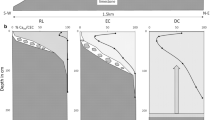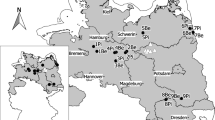Abstract
Background and Aims
Reduced availability of calcium (Ca) has been linked to maple forest decline. We therefore aimed at assessing the contribution of the different soil horizons to leaf Ca of competing beech (Fagus grandifolia Ehrh.) and sugar maple (Acer saccharum Marsh.) to better understand the dynamics of Ca uptake.
Methods
Leaf Ca was partitioned using the Ca/Sr ratio approach in two mature forests of southern Quebec. A mass balance was also used at one site to validate the results obtained with the Ca/Sr approach.
Results
The L and F horizons contributed most of the leaf Ca of beech and maple with likely small contributions from the upper B and/or H/Ahe horizons. Leaf Ca/Sr ratios of beech were however more variable than those of maple. Using a mass balance, the organic horizons and upper mineral soil horizons were found to provide ca. 80 and 20 % of tree Ca uptake, respectively.
Conclusion
Beech and maple Ca uptake depth apportionment is on average similar but beech is likely more plastic in sourcing soil Ca. The low contribution of the mineral soil to leaf Ca at our sites can be linked to less favorable conditions for Ca uptake likely associated with low Ca/Al ratios.





Similar content being viewed by others
References
Åberg G, Jacks G, Hamilton J (1989) Weathering rates and 87Sr/86Sr ratios: an isotopic approach. J Hydrol 109:65–78
Badibanga B, Pagé F, Sauvesty A, Ansseau C (1992) Le système radiculaire dans les érablières du Québec. II. Le développement radiculaire en relation avec le microrelief et la roche mère. Can J For Res 22:1568–1574
Baes AU, Bloom PR (1988) Exchange of alkaline earth cations in soil organic matter. Soil Sci 146:6–14
Bailey SW (2000) Geologic and edaphic factors influencing susceptibility of forest soils to environmental change. In: Mickler RA, Birdsey RA, Hom J (eds) Responses of northern U.S. forests to environmental change. Springer, New York, pp 27–49
Bailey SW, Hornbeck JW, Driscoll CT, Gaudette HE (1996) Calcium inputs and transport in a base-poor forest ecosystem as interpreted by Sr isotopes. Water Resour Res 32:707–719
Bailey SW, Horsley SB, Long RP, Hallett RA (2004) Influence of edaphic factors on sugar maple nutrition and health on the Allegheny Plateau. Soil Sci Soc Am J 68:243–252
Beauregard F, Côté B (2008) Test of soil extractants for their suitability in predicting Ca/Sr ratios in leaves and stems of sugar maple seedlings. Biogeochemistry 88:195–203
Bélanger N, Courchesne F, Côté B, Fyles JW, Warfvinge P, Hendershot WH (2002) Simulation of soil chemistry and nutrient availability in a forested ecosystem of southern Quebec. Part II. Application of the SAFE model. Environ Modell Softw 17:447–465
Bélanger N, Holmden C, Courchesne F, Côté B, Hendershot WH (2012) Constraining soil mineral weathering 87Sr/86Sr for calcium apportionment studies of a deciduous forest growing on soils developed from granitoid igneous rocks. Geoderma 185:84–96
Blum JD, Taliaferro EH, Weisse MT, Holmes RT (2000) Changes in Sr/Ca, Ba/Ca and 87Sr/86Sr ratios between trophic levels in two forest ecosystems in the northeastern U.S.A. Biogeochemistry 49:87–101
Blum JD, Klaue A, Nezat CA, Driscoll CT, Johnson CE, Siccama TG, Eagar C, Fahey TJ, Likens GE (2002) Mycorrhizal weathering of apatite as an important calcium source in base-poor forest ecosystems. Nature 417:729–731
Blum JD, Dasch AA, Hamburg SP, Yanai RD, Arthur MA (2008) Use of foliar Ca/Sr discrimination and 87Sr/86Sr ratios to determine soil Ca sources to sugar maple foliage in a northern hardwood forest. Biogeochemistry 87:287–296
Blum JD, Hamburg SP, Yanai RD, Arthur MA (2012) Determination of foliar Ca/Sr discrimination factors for six tree species and implications for Ca sources in northern hardwood forests. Plant Soil 356:303–314
Boucher P, Côté B (2002) Characterizing base cation immobilization in the stem of six hardwoods of eastern Canada. Ann For Sci 59:397–407
Bullen TD, Bailey SW (2005) Identifying calcium sources at an acid deposition-impacted spruce forest: a strontium isotope, alkaline earth element multi-tracer approach. Biogeochemistry 74:63–99
Capo RC, Stewart BW, Chadwick OA (1998) Strontium isotopes as tracers of ecosystem processes: theory and methods. Geoderma 82:197–225
Comas LH, Eissenstat DM (2004) Linking fine root traits to maximum potential growth rate among 11 mature temperate tree species. Funct Ecol 18:388–397
Courchesne F, Hendershot WH (1997) La genèse des Podzols. Géogr Phys Quat 51:235–249
Courchesne F, Turmel M-C, Beauchemin P (1996) Magnesium and potassium release by weathering in Spodosols: grain surface coating effects. Soil Sci Soc Am J 60:1188–1196
Courchesne F, Roy AG, Biron PM, Côté B, Fyles J (2001) Fluctuations of climatic conditions, elemental cycling and forest growth at the watershed scale. Environ Monit Assess 67:161–177
Courchesne F, Hallé J-P, Turmel M-C (2002) Bilans élémentaires holocènes et altération des minéraux dans trois sols forestiers du Québec méridional. Géogr Phys Quat 56:5–17
Courchesne F, Côté B, Fyles JW, Hendershot WH, Biron PM, Roy AG, Turmel M-C (2005) Recent changes in soil chemistry in a forested ecosystem of southern Quebec, Canada. Soil Sci Soc Am J 69:1298–1313
Cronan CS, Grigal DF (1995) Use of Ca/Al ratios as indicators of stress in forest ecosystems. J Environ Qual 24:209–226
Dambrine E, Loubet M, Vega JA, Lissarague A (1997) Localisation of mineral uptake by roots using Sr isotope. Plant Soil 192:129–132
Dasch AA, Blum JD, Eagar C, Fahey TJ, Driscoll CT, Siccama TG (2006) The relative uptake of Ca and Sr into tree foliage using a whole-watershed calcium addition. Biogeochemistry 80:21–41
Dijkstra FA, Smits MM (2002) Tree species effects on calcium cycling: the role of calcium uptake in deep soils. Ecosystems 5:385–398
Doyon F, Gravel D, Nolet P, Bouillon D, Majeau L, Messier C, Beaudet M (2003) L’envahissement par le hêtre dans les érablières de l’Outaouais: phénomène fantôme ou glissement de balancier. Institut québécois d’aménagement de la forêt feuillue, Ripon, 16 p
Drouet T, Herbauts J (2008) Evaluation of the mobility and discrimination of Ca, Sr and Ba in forest ecosystems: consequence on the use of alkaline-earth ratios as tracers of Ca. Plant Soil 302:105–124
Duchesne L, Ouimet R (2009) Present-day expansion of American beech in northeastern hardwood forests: does soil base status matter? Can J For Res 39:2273–2282
Duchesne L, Ouimet R, Houle D (2002) Basal area growth of sugar maple in relation to acid deposition, stand health, and soil nutrients. J Environ Qual 31:1676–1683
Fenn ME, Huntington TG, Eager C, McLaughlin SB, Gomez A, Cook RB (2006) Status of soil acidification in North America. J For Sci (Prague) 52:3–13 (Special Issue)
Gravel D, Beaudet M, Messier C (2011) Sapling age structure and growth series reveal a shift in recruitment dynamics of sugar maple and American beech over the last 40 years. Can J For Res 41:873–880
Gustafsson JP, van Hees P, Starr M, Karlum E, Lundström U (2000) Partitioning of base cations and sulphate between solid and dissolved phases in three podzolised forest soils. Geoderma 94:311–333
Hane EN (2003) Indirect effects of beech bark disease on sugar maple seedling survival. Can J For Res 33:807–813
Hendershot WH, Lalande H, Reyes D, MacDonald D (2007) Trace element assessment. In: Carter MR, Gregorich EG (eds) Soil sampling and methods of analysis, 2nd edn. CRC Press, Boca Raton, pp 109–119
Holmden C, Bélanger N (2010) Ca isotope cycling in a forested ecosystem. Geochim Cosmochim Acta 74:995–1015
Lajoie P, Baril R (1954) Soil survey of Montreal, Jesus and Bizard islands in the province of Quebec. Queen’s Printer and Controller of Stationary, Ottawa
Lefèvre F, Sardin M, Vitorge P (1996) Migration of 45Ca and 90Sr in a clayey and calcareous sand: calculation of distribution coefficients by ion exchange theory and validation by column experiments. J Contam Hydrol 21:175–188
Lyon J, Sharpe WE (1999) As assessment of the Ca:Al ratios of selected Pennsylvania forest soils. Water Air Soil Pollut 109:53–65
McLaughlin D (1998) A decade of forest tree monitoring in Canada: evidence of air pollution effects. Environ Rev 6:151–171
McNulty SG, Cohen EC, Myers JA, Sullivan TJ, Li H (2007) Estimates of critical acid loads and exceedances for forest soils across the conterminous United States. Environ Pollut 149:281–292
Momoshima N, Bondietti EA (1990) Cation binding in wood: applications to understanding historical changes in divalent cation availability to red spruce. Can J For Res 20:1840–1849
Näsholm T, Kielland K, Aneteg U (2009) Uptake of organic nitrogen by plants. New Phytol (Tansley Review) 182:31–48
Ouimet R, Arp PA, Watmough SA, Aherne J, Demerchant I (2006) Determination and mapping critical loads of acidity and exceedances for upland forest soils in Eastern Canada. Water Air Soil Pollut 172:57–66
Poszwa A, Dambrine E, Pollier B, Atteia O (2000) A comparison between Ca and Sr cycling in forest ecosystems. Plant Soil 225:299–310
Poszwa A, Dambrine E, Ferry B, Pollier B, Loubet M (2002) Do deep tree roots provide nutrients to the tropical rainforest? Biogeochemistry 60:97–118
Quirk JQ, Beerling DJ, Banwart SA, Kakonyi G, Romero-Gonzalez ME, Leake JR (2012) Evolution of trees and mycorrhizal fungi intensifies silicate mineral weathering. Biol Lett. 1 August 2012, doi:10.1098/rsbl.2012.0503
Read DJ, Leake JR, Perez-Moreno J (2004) Mycorrhizal fungi as drivers of ecosystem processes in heathland and boreal forest biomes. Can J Bot 82:1243–1263
Soil Classification Working Group (1998) The Canadian System of Soil Classification. Agric. and Agri-Food Can. Publ. 1646 (Revised). NRC Research Press, Ottawa, 187 pp
StatSoft, Inc. (2004) STATISTICA (data analysis software system), version 6, Tulsa, OK
Vizcayno-Soto G, Côté B (2004) A boundary-line approach to determine standards of nutrition for mature trees from spatial variation of growth and foliar nutrient concentrations in natural environments. Commun Soil Sc Plant Anal 35:2965–2985
Watmough SA, Aherne J, Alewell C, Arp P, Bailey S, Clair T, Dillon P, Duchesne L, Elmers C, Fernandez I, Foster N, Larssen T, Miller E, Miron M, Page S (2005) Sulphate, nitrogen and base cation budgets at 21 forested catchments in Canada, the United States and Europe. Environ Monit Assess 109:1–36
Whittaker RH, Likens GE, Bormann FH, Eaton JS, Siccama TG (1979) The Hubbard Brook ecosystem study: forest nutrient cycling and element behavior. Ecology 60:203–220
Yanai RD, Fisk MC, Fahey TJ, Cleavitt NL, Park BB (2008) Identifying roots of northern hardwood species: patterns with diameter and depth. Can J For Res 38:2862–2869
Acknowledgements
We would like to thank the Natural Sciences and Engineering Research Council of Canada and the Fonds Québécois de la Recherche sur la Nature et les Technologies for funding, and Hélène Lalande, Marie-Claude Turmel, Alain Brousseau, Erin Gertzen, Anne Murphy, Pierre-Olivier Quesnel, and Susan Beauregard for help in the field and in the laboratory.
Author information
Authors and Affiliations
Corresponding author
Additional information
Responsible Editor: Philip John White.
Rights and permissions
About this article
Cite this article
Chen, CC., Beauregard, F., Côté, B. et al. Partitioning of the source of leaf calcium of American beech and sugar maple using leaf Ca/Sr ratios: a predominantly surficial but variable depth of Ca uptake. Plant Soil 373, 229–242 (2013). https://doi.org/10.1007/s11104-013-1787-9
Received:
Accepted:
Published:
Issue Date:
DOI: https://doi.org/10.1007/s11104-013-1787-9




